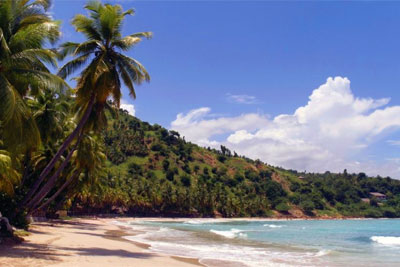 Jacmel
Jacmel
Jacmel, the « creative city », the cultural capital of Haiti, was founded in 1698. As a strategic port in the south and capital of the South-East department, this city prospered thanks to the maritime trade. Jacmel was the first city in the Caribbean to have access to electricity. It is becoming today one of the flagship tourist cities in the Caribbean. The seaside, the beaches and the artisanal creations make of Jacmel the 1st tourist city of Haiti.
Jacmel was a strategic port who played a significant role in the history of Haiti. It was disputed by Toussaint Louverture and Andre Rigaud, and commanded afterwards by Magloire Ambroise who saved the lives of hundreds of families in Jacmel at the time Rigaud lost the war with Toussaint.
After the Independence of Haiti in 1804, the governments of Dessalines and Petion strongly supported the liberation struggles in South America. The Venezuelan flag was created in Jacmel.
Throughout the year, the beaches of Raymond Les Bains, Ti Mouillage and Kabik remain an important tourist destination. The falls of Basin Bleu and Pichon are also well visited. Bassin Bleu is formed of three blue pools linked by waterfalls in the mountains located at 12 km northwest of Jacmel.
The carnival of Jacmel is one of the best in the Caribbean with its wealth of color, dance and artistic creation. Every year thousands of partygoers from everywhere come to the city to take part in this fantastic spectacle. Jacmel turns into one giant street theater for the event. The Jacmelian are very warm-hearted people with a festive behavior which earned them a fame of « banboche », « dyole » and « Pleziyis ».
On May 18, the Haitian Flag is celebrated in Jacmel with great parades of fanfares throughout the city, especially organized by the School of Music « Dessaix Baptiste ». The Patron Day is celebrated on May 1st with agricultural and artisanal fair and many musical groups which meet in the city for traditional concerts.
Want to order a tour to this city? Click here
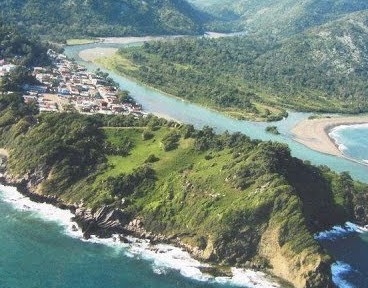 Mole St-Nicolas
Mole St-Nicolas
This is where Christopher Columbus landed for the first time in the island of Haiti on December 6, 1492, the Day of Saint Nicolas. By the late 1600s, France had gained control of Haiti from Spain and established “the Mole” as a remote outpost of its empire. This city is the pearl of the Northwest department, situated on an inlet of the Windward Passage, a strait between Haiti and Cuba, just about 60 miles from the east coast of Cuba. Nothing can interrupt watching the sun set over Cuba.
Mole St-Nicolas can be visited by car (4x4), by bus, by boat and by plane. The small airport receive flights from MAF and Sunrise Airways. Pegasus Diving based at Kaliko Beach organizes yatch trips to Mole St-Nicolas on weekends for groups from 5 to 20 people with diving activities.
Today, crumbling 18th Century French forts and massive rusting cannons spread along the coastline of Mole St-Nicolas. With its outstanding beauty this city remains one of the interesting tourist destination of Haiti. The land strip called Presqu’ile is a peninsula, a remote and forgotten area located seven miles from the City. Although it’s just a short distance from the Mole, it feels and looks like a place absent of any modern advances in technology. But if opening your mind and heart to the raw and unpredictable nature of life intrigues you, then joining in Mole St-Nicolas is strongly encouraged.
Want to order a tour to this city? Click here
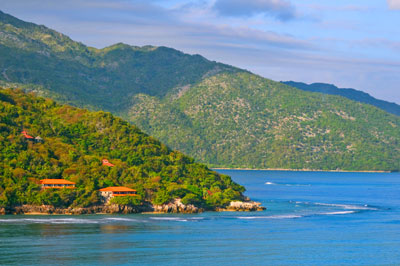 Cap-Haitian
Cap-Haitian
Cap-Haïtien is known for its French colonial architecture. This Haiti’s second city was the richest city in the Caribbean during the French colonial era. Although this is no longer the case, Cap-Haitien remains a relaxed atmosphere with its old architecture made of high shop fronts and gingerbread balconies and the local creole accent of its residents.
Cap-Haitien is surrounded by highly touristic places and among them the Citadelle Laferriere, also called Citadelle Henry Christophe, which is a hilltop fortress, the largest in the Americas, listed by UNESCO as a World Heritage Site in 1982. It was built by King Henry Christophe and is called by many the “eighth world wonder”. We must also mention the “Place de la Cathédrale” which is the landmark of the early-20th-century Notre-Dame Cathedral, the Vertieres Monument, the ruins of the 1813 Sans-Souci Palace in the nearby town of Milot, the sandy Cormier Plage northwest of the city on the way to Labadee.
The Labadee beach resort is one of the prime cruise destination of the Caribbean, located 9.7 km northwest of the Cap-Haitien. It is a stopover for Oasis of the Seas, the biggest cruise ship in the world operated by Royal Caribbean International. RCI employs around 300 local residents and enables 200 to sell their products in the facilities.
Vertières is the site of the last battle of independence opposing the indigenous troops led by Jean-Jacques Dessalines and the French colonial army led by Rochambeau. The French army was defeated there on November 18, 1803, which remains the Day of Army and Victory in Haiti.
Bois Caiman, south of Cap-Haitien, is where a leader named Dutty Boukman (or Bookman) organized a vodou ceremony, the first mass antislavery meeting at the beginning of the slave revolution on August 14, 1791. For decades many slave leaders organized the resistance movement with the maroons. We can name Mackandal, Cecile Fatima, Jean-Francois, Biassou, before the rise of Toussaint Louverture and Dessalines.
Want to order a tour to this city? Click here
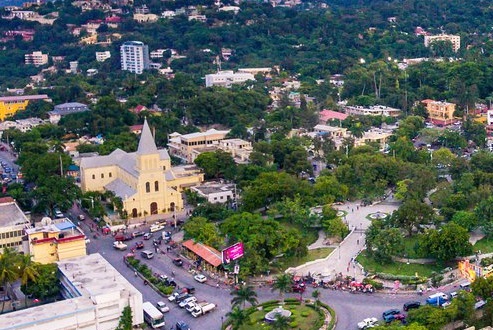
Petionville
Petionville is a city located in the metropolitan area of Port-au-Prince. Founded in 1831 by Jean-Pierre Boyer, its name comes from Alexandre Petion, one of the founder of the Haitian nation. It is the wealthiest city of Haiti where the majority of business activities and meetings take place. Petionville is well known for its boutiques and fine restaurants, art galleries, supermarkets, beauty parlors, fitness gyms, modern hotels etc. Petionville keeps an international standard in term of business and has a very active night life with bars, night clubs and casinos.
For visitors of Haiti, a stay or at least a stop in Petionville is highly recommended. The environment is safer compared to the other cities of the metropolitan area of Port-au-Prince. The majority of wealthy people and the foreign businessmen reside in this city. This makes it as well the most expensive place in the country. The gated neighborhood of Petionville, particularly of Morne Calvaire gives the impression of a Haitian version of Beverly Hills.
Want to order a tour to this city? Click here
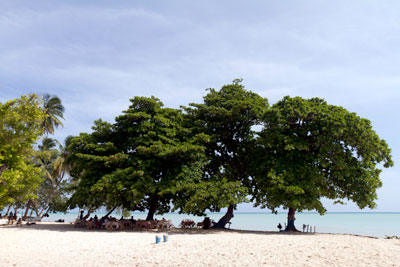 Les Cayes
Les Cayes
Les Cayes is the fourth largest city of Haiti and the capital of the South Department. It is located in the southern coastline of the country. It was founded in 1503 during the government of Nicolas de Ovando and was called “Zabana Salvatierra” (land of the saved water) for its rivers, beaches, waterfalls. Tourism is growing in Les Cayes although it is not attracting as many as Jacmel and Cap-Haitien.
The region of Les Cayes is wonderfully beautiful with a magnificent landscape that will leave you speechless and a tropical mild climate which is enjoyable during all time. This region offers some of the best exotic sea and mountain scenery in the Caribbean, with turquoise blue water beaches, pristine coral reefs and thick vegetation that covers most of its landscape. Its historic patrimony includes an arsenal and several fortresses dating from buccaneer times. Les Cayes was ravaged by fire in 1908 and by hurricane in 1954. It was also the witness of a massacre in December 1929 when US marines killed a dozen peasants protesting poor economic conditions under US occupation.
In Port-a-Piment, located a few miles from Les Cayes, you will discover the biggest cave system in the Caribbean: Grotte Marie-Jeanne. It is an extraordinary cave system in terms of natural resources including speleothems of all types, morphology and layout. It is flanked by a series of large passages and chambers.
Les Cayes host every year one of the biggest beach festival in the Caribbean: The Gele Festival, where thousands of people from the diaspora and from all over the country come to the region to enjoy the sea, the sun and the “Tonm-tonm”, grilled conch, fish and lobster of Gele Beach. In 2012, the famous Haitian National Carnival, one of the most important Caribbean Festival Event, was organized in Les Cayes.
If you want to help Haiti recover from its image assassination, think of coming to Les Cayes when you are thinking about a great laid-back, a quiet and rich vacation. If you believe everything that is said to showcase Haiti in the international media, you will surely miss the great opportunity to experience a unique adventure in the region of Les Cayes, Haiti. Two great resorts are welcoming tourists in the beautiful and unspoiled island of Ile-a-Vache: Port Morgan and Abaka Bay that has shorly been classified number 38 on CNN World’s most beautiful beach. The botanical garden of Les Cayes, located in Bergeau at the northern entrance of the city occupies an area of 8 hectares. Close to Les Cayes you will find as well Pic Macaya which is a protected natural park, the Saut-Mathurine waterfalls and the Kounoubois cave in Camp-Perrin, the Pointe-de-Sable beach in Port-Salut.
Want to order a tour to this city? Click here


